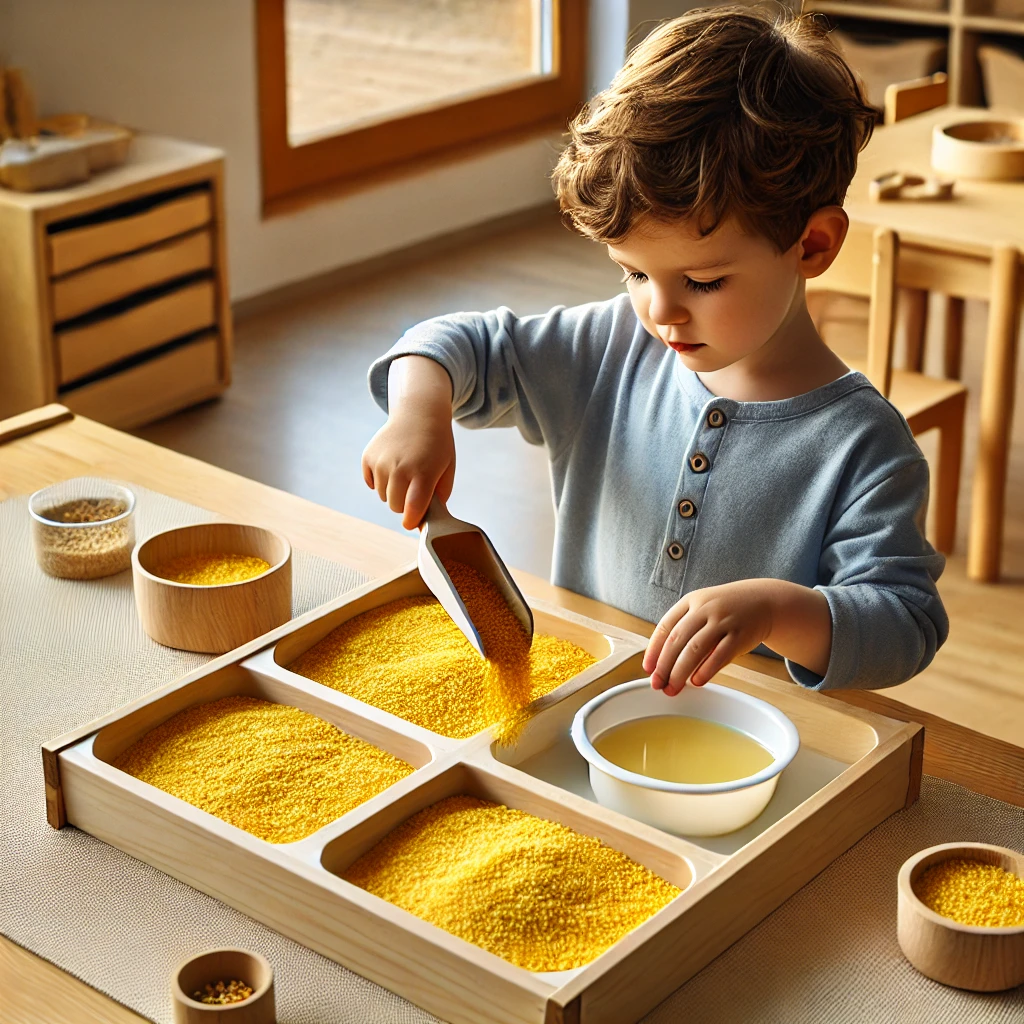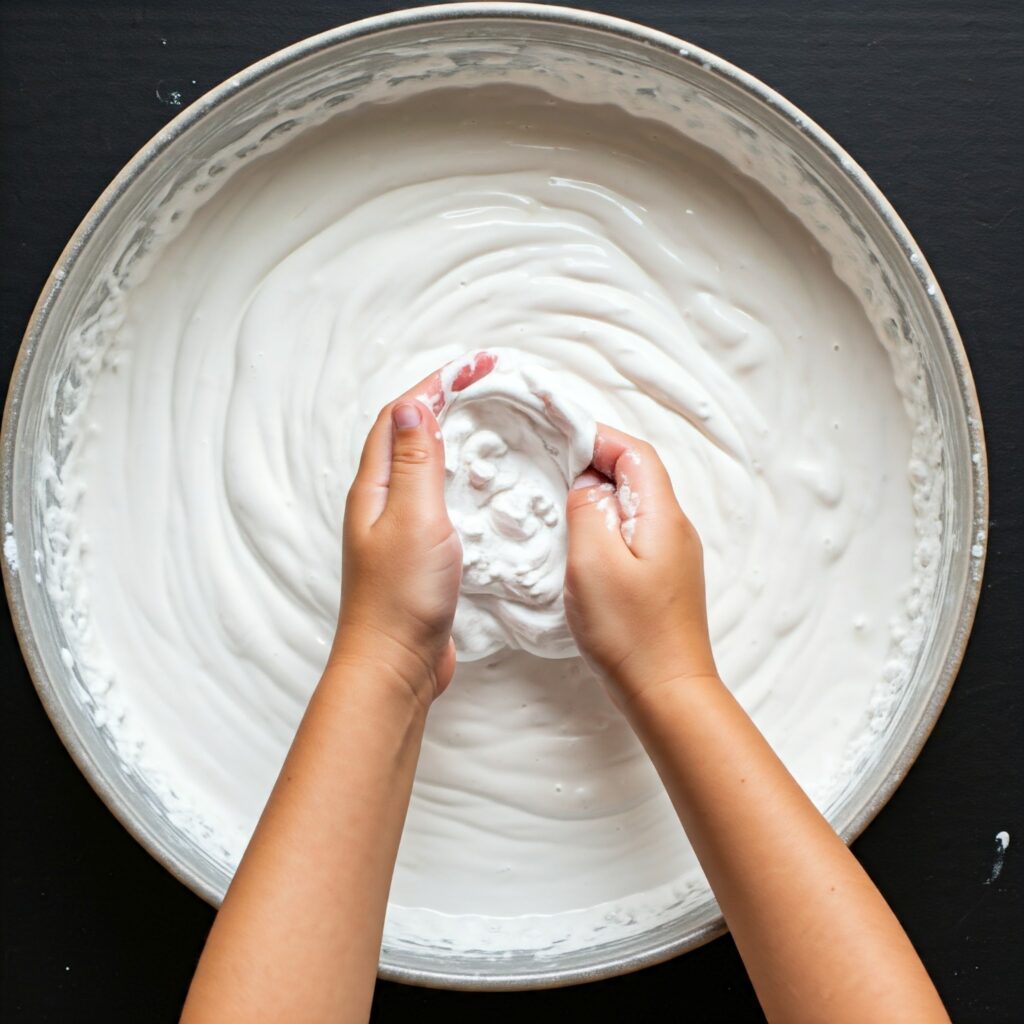When setting up a Montessori activity, the workshop should always be freely accessible. However, the presence of small objects makes this setup unsuitable for common living spaces with infants.
Therefore, this workshop can be offered either occasionally (for example, during the babies’ morning naps), in a separate room, or in a designated space that isn’t accessible to the little ones.
The Quintessential Montessori Activity: Connecting with Nature
The number one, the must-have, the least expensive and the richest experience for a child.
Whether you live in the countryside or have access to an urban park, you are lucky to be able to go out daily with children. Here are some ideas:
- Walking barefoot on the grass
- Listening to and naming natural sounds while blindfolded
- Feeling different textures (tree bark, soil, leaves, etc.), similar to Montessori rough texture boards
- Smelling natural scents (nature-inspired smell boxes)
- Transferring natural items (acorns, chestnuts, pebbles)
- Playing with mud (mixing soil and water = hours of fun!)
- Nature scavenger hunts (looking for a stick, a pebble, a chestnut, a green leaf, a yellow leaf, etc.)
- Telling stories outdoors
- Singing or napping under the trees
- Creating a snail farm, compost bin, or worm farm, and planting seeds
Water Transferring Activity
Transferring water – whether in the bathroom or kitchen during winter or outside in the garden or on the balcony in summer – remains a favorite activity for all children.
Materials: A basin, funnels, play tea set cups, syringes, pipettes, sponges, cloth squares… Anything is possible!
Water activities can also include:
- Giving baby dolls a bath, naming body parts
- Washing animal figurines
- Doing pretend dishes
More Easy and Fun Montessori Activity Ideas!

1- Transferring semolina: Set up a large cloth to catch spills, some containers, and provide supportive adult supervision.
- The activity “Transferring Semolina” is a simple, hands-on Montessori exercise designed to help young children develop fine motor skills, hand-eye coordination, and concentration.
- Here’s how it works and why it is beneficial:
- Setup: You’ll need a large cloth or mat to place on the floor or table to catch any spills. Then, set out containers of different sizes and shapes filled with semolina (or another small grain-like material) and provide additional empty containers for the child to transfer the semolina into.
- How It Works: The child uses their hands, a small scoop, or a spoon to transfer the semolina from one container to another. The process of transferring and managing the flow of the small grains requires focus and precision.
- Role of the Adult: An adult should supervise to ensure the child stays safe and comfortable but should step back and observe quietly, intervening only if necessary. The adult’s presence should be supportive rather than directive, allowing the child to experiment and learn at their own pace.
- Benefits for the Child:
- Fine Motor Skill Development: Handling the small grains strengthens hand and finger muscles, which is important for writing and other tasks.
- Concentration: The activity requires the child to focus and be attentive to detail.
- Practical Life Skills: Transferring activities mimic real-life tasks, preparing the child for future responsibilities.
- Overall, this activity is a calming and engaging way for children to develop important skills through play.

2- Gooey play (mixing cornstarch with water)
- Gooey Play (Mixing Cornstarch with Water) is a fun and sensory-rich Montessori-inspired activity that captivates children and teaches them about the properties of different materials. Here’s a breakdown of how it works and why it’s beneficial:
- How to Set It Up:
- Materials Needed:
- Cornstarch
- Water
- A large bowl or tray
- Optional: Food coloring for added fun (if safe and appropriate)
- Mixing Instructions:
- Start by adding cornstarch to the bowl.
- Slowly add water, mixing until the cornstarch becomes a unique, gooey substance. The texture should be firm when you press or squeeze it but turns liquid and flows when you let go.
- What Happens:
- This mixture is called a “non-Newtonian fluid,” meaning it behaves both like a solid and a liquid depending on how you apply pressure. Children are fascinated by how they can grab it like a solid and watch it drip away like a liquid.
- Role of the Adult:
- An adult should supervise and guide the child in exploring the different ways to manipulate the gooey mixture. Encourage them to squeeze, poke, and let it flow through their fingers. The adult’s role is to facilitate learning and ask questions that make the child think about the experience.
- Benefits for the Child:
- Sensory Exploration: Gooey play engages the senses, helping children explore touch and the properties of materials.
- Fine Motor Skills: The squeezing and manipulating motions help strengthen hand and finger muscles.
- Scientific Thinking: Children begin to understand basic concepts of physics and material properties.
- Creative Play: This activity allows for open-ended exploration, which fosters creativity and imagination.
- Cleanup Tips:
- Make sure to do this activity in an easy-to-clean area. Have paper towels and a trash bin nearby, as the cornstarch mixture should be thrown away rather than washed down the drain to avoid clogs.
- This gooey play activity is a wonderful way for children to engage in hands-on learning while having a blast. Let me know if you’d like more ideas or suggestions for other similar activities!
3- Lock and key games (on a tray)
- Lock and Key Games (on a Tray) is a Montessori-inspired activity that captivates children’s interest while developing practical life skills, fine motor coordination, and problem-solving abilities. Here’s how it works and why it’s a great addition to your Montessori activities:
- How to Set It Up:
- Materials Needed:
- A sturdy tray
- A variety of small locks and matching keys (you can use padlocks of different sizes, shapes, or colors)
- Ensure that each lock has its own corresponding key
- Setup Instructions:
- Arrange the locks and keys neatly on the tray, keeping the keys separate but within reach of the locks.
- You can also organize the locks by size or color to add an element of matching and sorting.
- How It Works:
- The child selects a lock and tries different keys until they find the one that fits and opens the lock. Once successful, they can lock it again and try a different combination. This activity is an engaging way for children to practice matching and figuring out how things work.
- Role of the Adult:
- The adult introduces the activity, explaining how each lock has a matching key. After a brief demonstration, the adult steps back to let the child explore independently. Observing quietly is important to give the child space to figure things out but be ready to offer gentle encouragement if needed.
- Benefits for the Child:
- Fine Motor Skills: Manipulating small locks and keys helps to strengthen hand and finger muscles, improving dexterity and preparing the child for writing and other tasks requiring precision.
- Hand-Eye Coordination: Aligning the key with the lock’s keyhole helps improve hand-eye coordination.
- Problem-Solving Skills: The child learns to experiment and problem-solve by trying different keys until they find the right one. This fosters a sense of accomplishment and persistence.
- Practical Life Skills: Lock and key games mimic real-life tasks, teaching children how locks work, which is a useful skill for everyday life.
- Variations and Extensions:
- Sorting by Color or Size: If you have locks and keys of different colors or sizes, encourage the child to sort and match them before opening.
- Timed Challenge: For older children, add a playful element by timing how quickly they can match and open all the locks.
- Storytelling: Use locks to make a treasure chest or “magic box” game, where unlocking the box reveals a surprise or a small reward.
- This activity is not only fun but also deeply satisfying for young learners. It promotes independence and keeps them engaged while learning through play.
The list goes on, and with a little creativity, you can come up with many more ideas. All these activities use recycled materials or come at a very low cost.
Encourage Autonomy in Montessori Activities
“Help me to do it myself” perfectly sums up the Montessori philosophy.
It’s about giving children the opportunity to learn how to do things on their own, appropriate to their age and abilities. Trusting the child and allowing them to carry out tasks independently – under supervision and after a demonstration in a safe, adapted environment – is key.
How to Encourage Independence?
Encouraging independence involves:
- Learning to wash their hands alone
- Carrying a tray (most materials are presented this way)
- Pouring water from a small glass pitcher to a real glass
- Cutting a piece of cake or making a fruit salad (under supervision)
- Following a recipe
- Learning to clean up a mess they made
- Dressing and undressing themselves
- Setting the table
- Arranging flowers for decoration
The Role of the Accompanying Adult
The adult should intervene only when necessary, after observing the child and their environment carefully. The adult supports with kindness and discretion, respecting the child’s developmental needs.
Childcare professionals should prioritize observing and refrain from giving instructions or solutions. The adult serves as a role model for the child, acting with subtlety, thoughtfulness, and respect.

